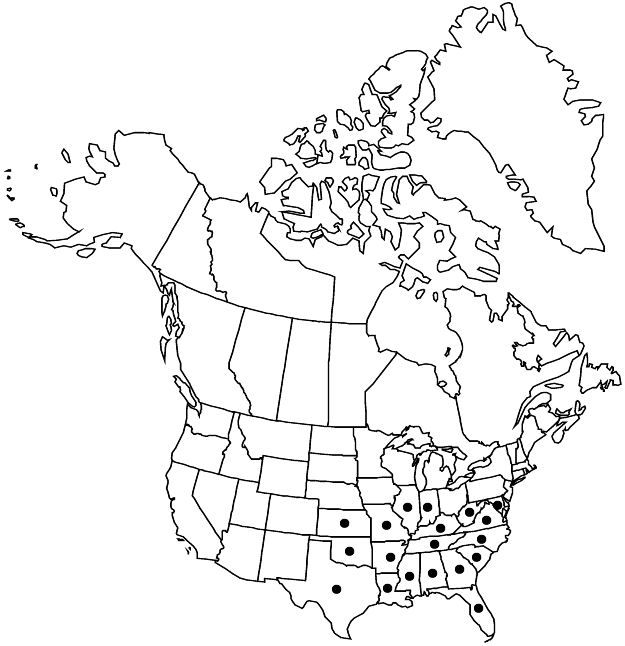Crataegus viridis
Sp. Pl. 1: 476. 1753.
Shrubs or trees, 80–150 dm. Stems: mature trunk bark checked dark gray or black, rough or whitish to light gray, thin-exfoliating; twigs: new growth often reddish, glabrous, 1-year old gray to red-brown, older gray, smooth; thorns on twigs few to abundant, 2-years old blackish, 3–4 cm. Leaves: petiole 0.7–2.5 cm, length 33–40% blade, adaxially glabrous or pubescent, eglandular; blade narrowly elliptic to suborbiculate, narrowly rhombic to oblong and ovate, oblanceolate, 2–6(–7) cm, thin (except in vars. glabriuscula and nitens), base cuneate to rounded, lobes 0 or 1–3 per side, margins serrate (teeth 0–2 mm) to obscurely crenate-serrate in distal 1/2 only, venation craspedodromous, sometimes semicamptodromous, veins 3–5(–7) per side, apex ± acute to obtuse, surfaces usually glabrous, except with tufts of hair in abaxial vein axils. Inflorescences (3–)10(–50)-flowered; branches usually glabrous, sometimes densely hairy young; bracteoles ± eglandular, except somewhat glandular in var. glabriuscula. Flowers (10–)13–15(–18) mm diam.; hypanthium usually glabrous (hairy in C. viridis var. velutina); sepal margins ± entire; anthers cream or ivory. Pomes orange to deep red, rarely yellow, not pruinose, orbicular, 5–8 mm diam.; sepals recurved. 2n = 34, 51.
Distribution

se United States.
Discussion
Varieties 6 (6 in the flora).
Crataegus viridis ranges from southeastern Texas along the coastal plain and piedmont to central Florida and to tidewater Maryland; inland, it extends to near St. Louis, Missouri, and the Tennessee-Kentucky border. The species favors streamsides and moist, fertile, alluvial woodlands or agricultural derivatives of these.
Crataegus viridis is variable in leaf shape and size. The varieties intergrade somewhat and most are sympatric; they are valuable for recognizing variation. Varieties glabriuscula and velutina are regional.
Beyond the recognized varieties, sporadic forms exist with yellow or gold fruit or anthocyanic anthers. Crataegus arborescens Elliott from northern Florida is similar to C. viridis but has rose-purple anthers and slightly hairy inflorescence branches. Other local forms with red or pink anthers, such as C. antimina Sargent, C. enucleata Sargent, and C. pechiana Sargent, are found. Selected forms with bright, rather deep green foliage, and heavy crops of red fruit, for example, cultivar Winter King, are ornamentals.
Rare putative interserial hybrids exist with ser. Crus-galli (for example, Crataegus ×permixta E. J. Palmer), ser. Molles (for example, C. ×anamesa Sargent, C. ×poliophylla Sargent, C. ×stenosepala Sargent), and ser. Punctatae (J. B. Phipps 2005).
Selected References
None.
Lower Taxa
Key
| 1 | Young leaf blades, inflorescence branches, and hypanthia densely hairy. | Crataegus viridis var. velutina |
| 1 | Young leaf blades, inflorescence branches, and hypanthia glabrous except for tufts of hair in vein axils of abaxial leaf surfaces | > 2 |
| 2 | Leaf blades broadly lanceolate to narrowly rhombic, lobes distinct, 2 or 3 per side, sinuses shallow to moderately deep, max LII 15–40%, veins 4 or 5 per side. | Crataegus viridis var. viridis |
| 2 | Leaf blades ± lanceolate, narrowly to broadly elliptic or rhombic-elliptic to narrowly obovate or oblong to ovate or ± orbiculate, lobes mostly obscure or short, 0 or 1(–3) per side, max LII 5(–20)%, veins 3–7 per side | > 3 |
| 3 | Leaf blades broadly elliptic to ovate, 3–4 cm, lobes 0 or 1–3 per side, sinuses shallow to deep, coriaceous; 1-year old twigs reddish brown. | Crataegus viridis var. nitens |
| 3 | Leaf blades ± lanceolate, narrowly to broadly elliptic or rhombic-elliptic, narrowly obovate or oblong to oblong-ovate, or ± orbiculate, 2–6.3 cm, lobes 0, or 1 or 2 per side and very short or rarely 1 per side and longer, but then not on most leaves, sinuses shallow, thin to chartaceous; 1-year old twigs gray, dark gray, or tan to reddish brown | > 4 |
| 4 | Leaf blades ± lanceolate, narrowly elliptic to narrowly obovate or oblong, veins 3–7 per side. | Crataegus viridis var. lanceolata |
| 4 | Leaf blades oblong, broadly elliptic, rhombic-elliptic or oblong-ovate to ± orbiculate, veins 3–5 per side | > 5 |
| 5 | Leaf blades broadly elliptic to oblong-ovate, sometimes suborbiculate, 2.5–6.3 cm, marginal teeth 1 mm, veins 4 or 5 per side. | Crataegus viridis var. ovata |
| 5 | Leaf blades ± orbiculate to narrowly ovate, oblong, rhombic-elliptic, or narrowly obovate, 2–4 cm, marginal teeth 1.5–2 mm, veins 3(or 4) per side. | Crataegus viridis var. glabriuscula |